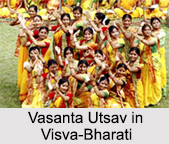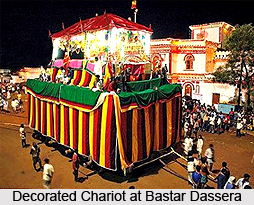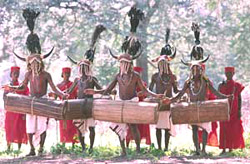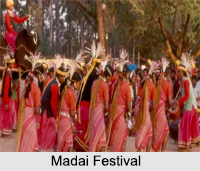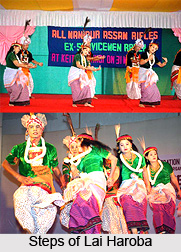 Lai Haroba is a folk dance of the Manipur state of India. This traditional dance depicts the creator and is also considered the precursor of Manipuri. This dance is performed to appease the gods. Since its inception, the dance was performed in the temples. Now these dances are staged and have become famous. There are almost more than 400 shrines depicting various animistic deities in Manipur. The Lai Haroba festival is celebrated in their honour each spring till the advent of monsoons.
Lai Haroba is a folk dance of the Manipur state of India. This traditional dance depicts the creator and is also considered the precursor of Manipuri. This dance is performed to appease the gods. Since its inception, the dance was performed in the temples. Now these dances are staged and have become famous. There are almost more than 400 shrines depicting various animistic deities in Manipur. The Lai Haroba festival is celebrated in their honour each spring till the advent of monsoons.
Origin of Lai Haroba
Lai Haroba dance originated from Sidaba, considered as the creator and great Guru of dancing. Through the physical movements and gestures of Sidaba, the Lai Haroba dance evolved. Later along with Leimaren (Mother Goddess), the great Guru finished the creation. Afterwards other gods and goddesses also adapted the creation dance.
Performance of Lai Haroba
The dances are performed in front of a temple in a given open space. The dance festival commences with bestowing of fruits and flowers to god. This is usually performed by the girls who are lead by the `Maibis`, priestess-oracles. Subsequently, the boys select their girl partners for dancing and entertainment. `Nandai Jogai`, a type of Lai Haroba depicts the division of the sky surrounding the Earth into two. Thus, this dance is illustrated by lifting of hands in the sky and dividing it. There are twelve types of Lai Haroba dance.
Lai Haroba is performed by both male and female dancers. They either perform solo or in duets. It is sometimes performed by a group of boys and girls or males and females in separate groups. Occasionally during a duet Lai Haroba performance, a male person sings the song and the other performers dance accordingly. The dance starts with the slow movements of the hands. It is followed by the rhythmic beating of the feet on the ground. Gradually the rhythm of the dance increases and at the end the dance concludes with the dancers bowing to the gods and to the spectators. They rest their palms on the ground and touch them with their heads.
Musical Instruments of Lai Haroba
The musical instruments play an important role in the Lai Haroba dance. The orchestra of Lai Haroba comprises of a big drum, big gongs, bamboo flutes, `Manjira` (small cymbals) and a `Pena`. Pena is a stringed instrument of Manipur. The instrument is made up of a coconut which is broken into two halves. A round piece of leather is glued on one of the dried half shell of the coconut. Then a link is fixed in the centre. A piece of bamboo or wood is attached to the shell having some strings which are made up of hairs of a horse"s tail. These are attached at both ends. Once the instrument is made it produces a `Sarangi` like effect.
Costume of Lai Haroba
The Lai Haroba costume known as Aharya is based on the designs of the Munipur. The dress patterns bear its reference to mythological customs of Manipur. The sari worn by them is a one piece long cloth which is tied at the waist. It has a dark green background with golden stripes and decorated borders. Along with the sari satin half sleeved blouse is also worn. The head dress worn during the Lai Haroba dance is made up of thick green velvet fur fabricated with golden ribbons. The females decorate them with attractive ornaments like necklaces, ear rings and bracelets. The long flowing hair that sways with the movement of the head adds charm to their looks. The male dancers do not wear an upper garment. Their dhotis are made up of a coloured silk cloth. They also decorate themselves with ornaments like necklaces, armlets and rings.
Before the advent of the Vaishnavism among the Manipuris, the Lai Haroba had a prominent place among them. It was an important custom to perform the dance during the worship of their guardian deities like Thangjing, Wangbaren, Maijing, Koubru and Pakhangba, the royal deity. The Lai Haroba dance technique was later manifested into the Khamba and Thoibi dance pattern.

